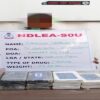Electricity generation in the country fell below the 4,000 megawatts mark on Sunday as 11 plants were idle, even as several others suffered declines in the output.
Total power generation fell to 3,922.2MW as of 6am on Sunday from 4,394MW on Saturday, according to data obtained from the Nigerian Electricity System Operator.
Eleven of the power plants on the national grid did not generate any megawatts of electricity as of 6am on Sunday.
The idle plants included six of those built under the National Integrated Power Project, namely Geregu II, Sapele II, Olorunsogo, Omotosho, Ihovbor, and Gbarain. The others were Afam IV&V, Ibom Power, AES, ASCO and Egbin ST6.
The data showed that generation capacity of 2,830.7MW could not be utilised as of 6am on Sunday as a result of gas constraints, low load demand by the distribution companies and water management.
Egbin, the nation’s biggest power station, saw its output drop to 664MW as of 6:00am on Sunday from 882MW.
Generation from three units (ST1, 2 and 4) at Egbin, located in Lagos, was said to have reduced due to low load demand by the distribution companies; generation from ST3 reduced due to gas constraint, while that of ST5 was limited to 169MW due to boiler tube problem.
Two of the nation’s Discos, Ikeja Electric and Eko Electricity Distribution Company, recently attributed the drop in power supply in Lagos to a shortage in the allocation received from the national grid.
The Discos informed their customers via Twitter that the reduction in power allocation resulted from load shedding by the government-owned Transmission Company of Nigeria, which manages the grid.
The nation generates most of its electricity from gas-fired power plants, while output from hydropower plants makes up about 30 per cent of the total generation.
The system operator put the nation’s installed generation capacity at 12,954.40MW; available capacity at 7,652.60MW; transmission wheeling capacity at 7,300MW; and the peak generation ever attained at 5,801.60MW.
PUNCH
![]()




























































